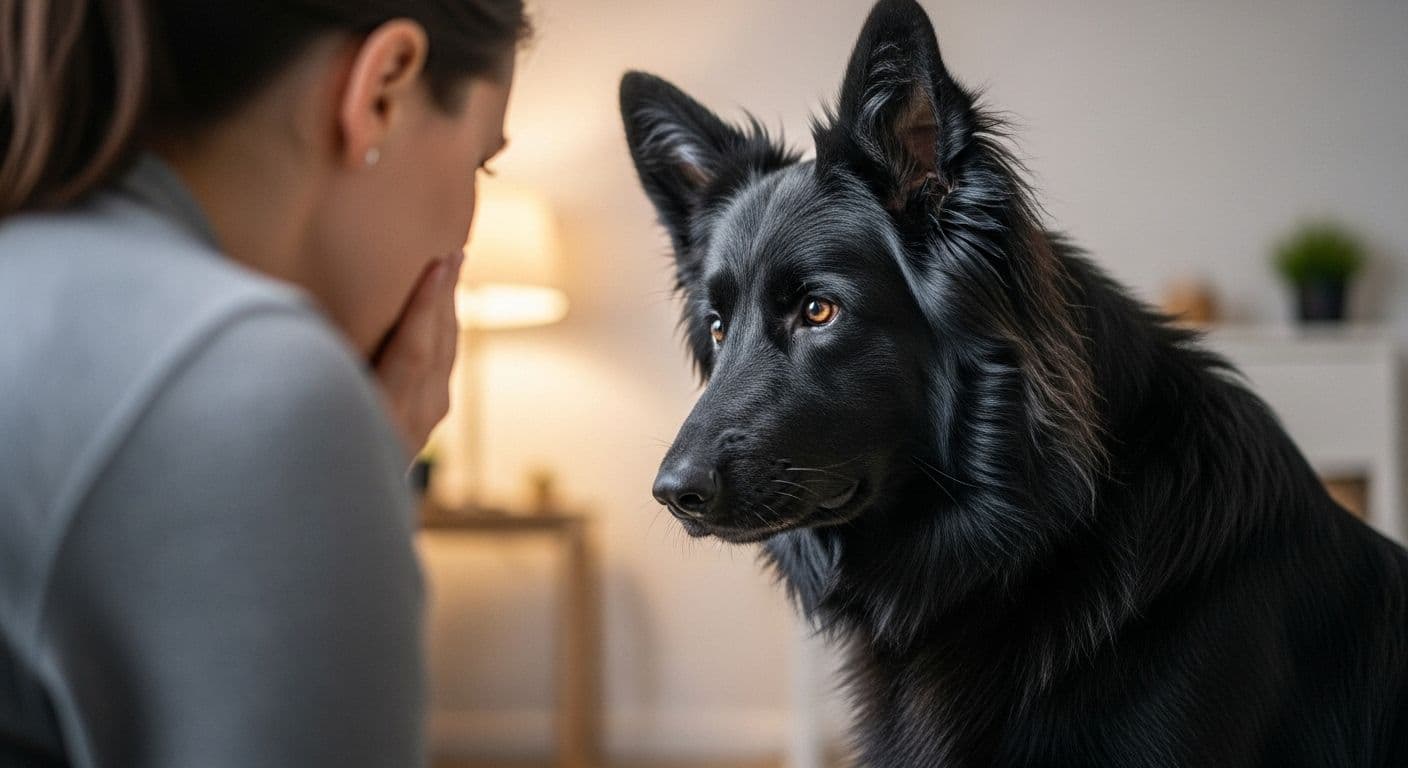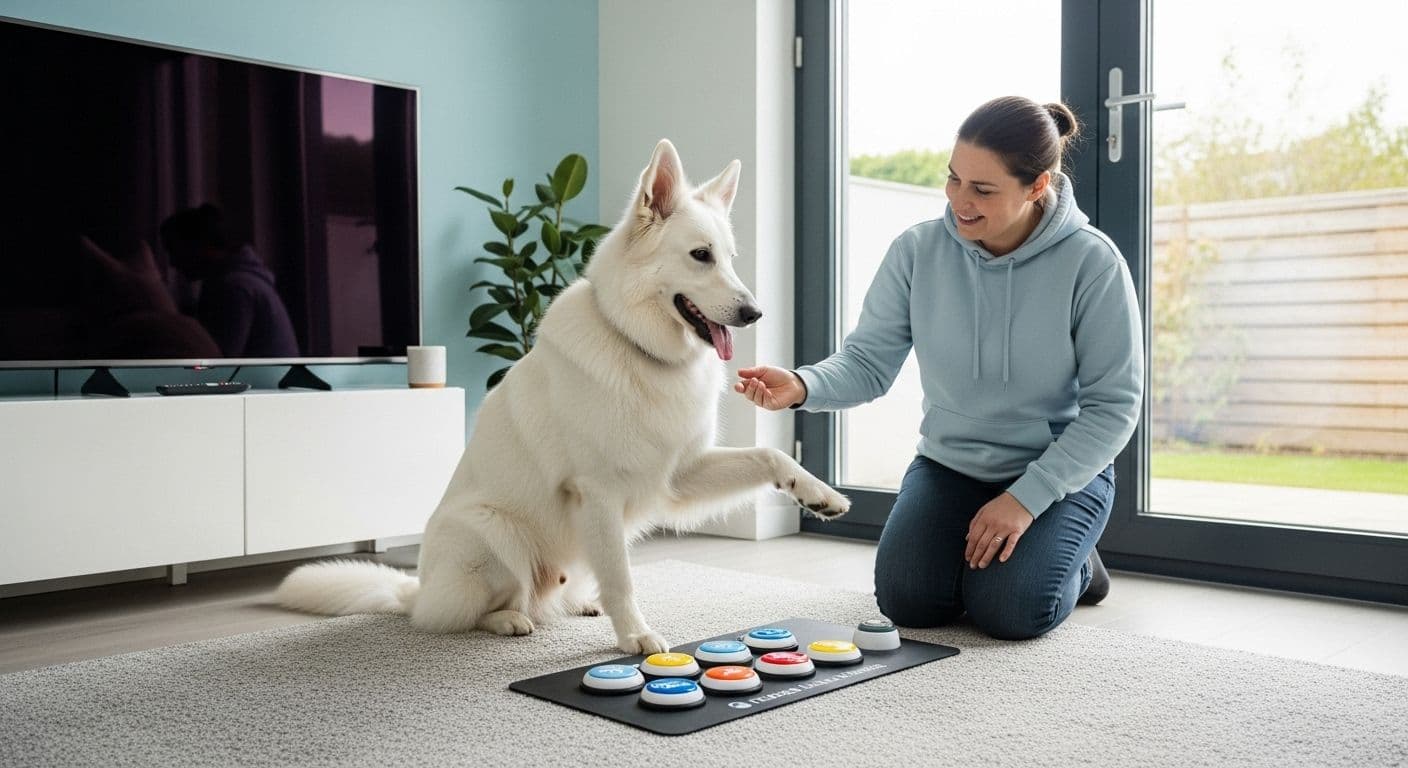Teaching your dog to vocalize on command is a fun and engaging way to strengthen your bond and improve communication. If you’re wondering how to teach your dog to speak, this guide is for you. We’ll walk through a positive, humane approach that focuses on reward-based learning to build trust and make training an enjoyable activity for you both.
This guide is designed for any dog owner who wants to use positive reinforcement to teach a new skill. We'll cover everything from barking on cue to the "quiet" command and even explore advanced tools like dog talking buttons.
Read Your Dog First

Before you can teach your dog to "speak" in a way you understand, it's crucial to first learn how to speak dog. This means understanding their natural communication signals and building a foundation of trust.
Understand Canine Vocalizations
Dogs are always communicating, but it's easy for us to misinterpret their signals. Instead of labeling behavior as “stubborn” or “dominant,” look at the context and your dog's body language. A growl might indicate fear, not aggression, and a dog that freezes still is showing a defensive reaction, not defiance. Tight, stiff body language often points to stress, not willful disobedience.
How to Talk to Dogs
Effective communication is a two-way street. Your body language, tone, and timing are just as important as your dog's.
- Body Language: Approach your dog with a calm, relaxed posture. Standing sideways is less threatening than a head-on approach. Avoid prolonged eye contact or hovering over your dog, as this can be intimidating. Let them approach you on their terms.
- Tone of Voice: Use a low-pitched voice for calm confidence and a high-pitched, cheerful tone for praise. A calm, prolonged "Noooo" can discourage an activity without using a harsh or angry tone, which only increases stress.
- Timing: The key to clear communication is immediate feedback. Mark desired behaviors with a "Yes!" or a click the instant they happen, then deliver a reward within a few seconds.
- Consent: Build trust by giving your dog a choice. A great way to do this is with the "chin rest consent test." Teach your dog to rest their chin in your open palm. When they offer this behavior voluntarily, it signals they are ready for an interaction like petting or grooming. If they lift their chin, respect their signal and pause the interaction.
Choosing Motivators and a Marker
To train effectively, you need two things: a reward your dog loves and a clear signal that tells them they've earned it.
- Find High-Value Motivators: Offer your dog a choice between different treats (like small pieces of chicken, cheese, or their favorite training treats) to see which they prefer. Their top-choice rewards should be reserved for learning new or difficult skills.
- Choose and "Charge" Your Marker: A marker is a signal that a reward is coming. It can be a clicker or a short, unique word like "Yes!" or "Nice!" To charge your marker, simply say the word or click, then immediately give your dog a high-value treat. Repeat this 10-15 times in a short session. When the sound of the marker makes your dog look at you expectantly, it's charged and ready for training.
How to Teach Your Dog to Speak (Bark on Cue)

With a foundation of trust and a clear marker system, you're ready to learn how to train a dog to speak. The goal is to teach your dog to bark once on a specific verbal cue and hand signal.
Capture a Natural Bark
The easiest way to teach "speak" is to capture a bark that happens naturally.
- Elicit a Bark: Use a mild trigger that you know makes your dog bark, like a knock on the door or a specific toy.
- Mark and Reward: The moment your dog barks, mark it with your clicker or "Yes!" and immediately give them a high-value treat.
- Add Your Cue: Once your dog reliably barks at the trigger, start adding your cue. Say "Speak" (and use a hand signal if you want) right before you present the trigger. After a few repetitions, your dog will start to associate the word with the action.
How to Teach a Dog to Speak If They Rarely Bark
If your dog isn't a big talker, you'll need to be patient. Use a trigger they find mildly exciting, like a favorite toy or a doorbell sound. Start by rewarding any small vocalization, even a grumble, and gradually shape it into a full bark. Once they understand the game, you can start fading the trigger so they respond to the "Speak" cue alone.
How to Teach a Dog to Speak Without Overexciting Them
The goal is a single, controlled bark, not a frantic barking session.
Tip: To keep arousal low, mark and reward only a single bark. If your dog barks multiple times, wait for a brief pause, then reward the moment of silence. This teaches them that one bark is what earns the treat.
Keep training sessions short (5-10 minutes) and end on a positive note. If you see your dog getting too excited, take a sniff break or ask for a calming behavior like "go to your mat." If frantic barking or whining appears, it's a sign to end the session. This teaches your dog that calm behavior is what keeps the fun training game going.
Progression and Proofing
Once your dog understands the "speak" cue in a quiet room, it's time to help them generalize the skill.
- Week 1-2: Focus on capturing the bark and adding your cue.
- Week 3: Start fading the trigger, asking for a bark with just the verbal cue.
- Week 4: Practice in a different, low-distraction room in your house.
- Week 5+: Gradually introduce controlled distractions, like practicing in the backyard or with another person in the room. Switch to a variable reward schedule (rewarding randomly) to keep the behavior strong.
This method shows you how to train a dog to speak with positive reinforcement, creating a reliable skill without causing stress or frustration.
Keep It Polite: Train "Quiet" and Self-Control
Teaching "speak" should always go hand-in-hand with teaching "quiet." This gives you an off-switch and ensures your new trick doesn't become a nuisance.
Teaching a Reliable Quiet Cue
The best way to teach "quiet" is by rewarding the opposite of barking—silence. This is a form of differential reinforcement.
- Ask your dog to "speak."
- After they bark, hold a high-value treat up to their nose. They'll stop barking to sniff it.
- The instant they are quiet, mark ("Yes!") and give them the treat.
- Once they reliably become silent for the treat, add your verbal cue ("Quiet" or "Shh") as they stop barking.
- Gradually increase the duration they must remain quiet before getting the reward, starting with just a second or two.
Important: Never yell "Quiet!" at your dog. This can sound like you're barking along with them and may increase their anxiety, making the problem worse.
Build Duration and Impulse Control
To prevent "speak" from spiraling into demand barking, you need to build your dog's self-control.
- Calm-on-Mat Training: Teach your dog to go to a mat or bed and settle. This is an incompatible behavior—they can't be barking reactively if they are calmly lying on their mat.
- "Look At That" (LAT): For dogs who bark at triggers like people walking by, teach them to look at the trigger and then look back at you for a treat. This changes their emotional response from reactive to calm and focused.
Prevent Nuisance Barking with Management
Management is key to preventing nuisance barking while you train.
- Visual Barriers: Use window film or close blinds to block sightlines to the street.
- Sound Masking: A white noise machine or fan can help drown out external sounds that trigger barking.
- Enrichment: A bored dog is often a noisy dog. Provide puzzle toys, scent games (like a "find it" game with kibble), and safe chew toys to keep their mind busy.
- Exercise: Ensure your dog gets enough physical and mental exercise each day. A tired dog is a quiet dog.
Beyond Barking: How to Teach a Dog to Talk with Buttons

For owners who want to take communication to the next level, dog talking buttons offer a fascinating way to give your dog a "voice." Instead of barking on cue, your dog can learn to press a button to express a specific need or want.
Getting Started with Dog Talking Buttons
Expert Tips for Teaching Your Dog to Talk with the PETOPIX Button Set
To begin, you'll need a set of recordable buttons and a non-slip mat to hold them in place. Choose buttons that are durable and easy for your dog's paw or nose to press.
- Pick First Words: Start with 1-2 high-frequency, motivating words. "Outside," "Play," and "Water" are excellent choices because the reward is the activity itself.
- Record Your Voice: Record the words on the buttons using a clear, enthusiastic tone.
- Place the Buttons: Put the buttons in a logical, consistent location. For example, the "Outside" button should be near the door.
The key to teaching is modeling. Every time you are about to perform the action, say the word, press the button yourself, and then immediately follow through. For instance, before opening the door, say "Outside," press the "Outside" button, and then let your dog out.
Prevent Button Mashing
Some dogs get excited and start "mashing" the buttons. To encourage purposeful presses, only reward a single, clear press. If your dog gets frantic, briefly remove access to the buttons to help them calm down. You can also introduce buttons like "All Done" to signal that an activity is over.
Dog Communication Buttons Setup
Consistency is crucial for success with dog buttons for communication.
- Layout: Keep the buttons in the exact same location so your dog builds muscle memory. You can cluster them by category (e.g., activities, people).
- Consistency: Every member of the household should model the buttons in the same way.
- Tracking Usage: Keep a simple log of when your dog uses a button, in what context, and how you responded. This helps you track progress and identify which words are most motivating for them.
Troubleshooting Dog Buttons
If your dog isn't pressing the buttons, review your setup.
- Is the reward valuable enough?
- Is the button in a logical spot?
- Are you modeling consistently?
- Are you giving your dog enough time to think without over-prompting?
If your dog shows signs of frustration (like yawning, lip licking, or avoiding the buttons), take a break. Reduce the number of buttons back to one and make the game easier. Communication should always be their choice.



